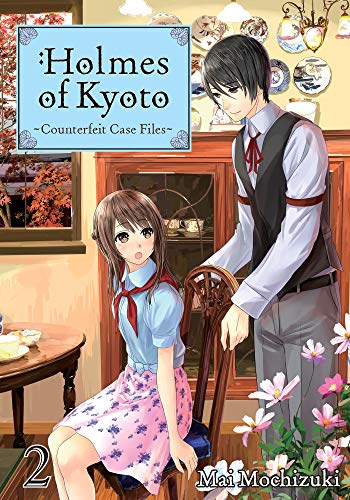By Mai Mochizuki and Shizu Yamauchi. Released in Japan by Futabasha. Released in North America by J-Novel Club. Translated by Minna Lin.
I think the thing I find most amusing about Holmes of Kyoto is how it can’t seem to settle down in one particular genre. It’s supposed to be in the ‘light mystery’ genre, mostly involving forged antiques, and it definitely is that for a good deal of the book. The SOLUTION to said mysteries, though, is rarely the point and often an afterthought – at one point the book sets up an elaborate locked room mystery, complete with witnesses giving testimony that the reader is supposed to use to deduce the truth… and then solves the mystery immediately. There’s also the “let’s tour Kyoto and talk about how awesome it is” parts of the book, which are just as important as the mystery, and at times this seems like one of those travelogue style books where each chapter has the heroes at a new landmark. And of course it’s also a simmering slow-burn romance, one that actually seems to be on both sides this time, if still not going anywhere. The fact that the book balances all these sides perfectly is what makes it so fun.
These books are less novels and more collections of short stories, as we see Aoi and Holmes attend his grandfather’s birthday party (and deal with a smashed priceless antique); help a former art forger trying to make things right with his former victim; go to a temple where someone has theoretically stolen something precious… but they’re not sure what; tour a seemingly haunted house; and finally attend another party where they judge a series of paintings and antiques to show off their appraisal skills, only to find that the best among them may be our talented young heroine. The latter half of the book also introduces a new character who appears to be an ongoing antagonist to our hero… and while he’s not named Moriarty he’s certainly aware of the connection, and just as crafty as Holmes is.
I spoke last time that Aoi’s crush on Holmes was fairly one-sided, and that’s starting to change, and not just because everything they do together reminds people of a married couple. Aoi’s innocent and strong conviction is something that the usually too cynical Holmes needs in his life, and you get the sense that he might have told her so at the end of this book were it not for the presence of Akihito. I suspect Akihito’s appearances in this book might frustrate some readers. He is there to be comic relief, to be another person to have things explained to by Holmes, and to make sure that Holmes and Aoi don’t actually get closer than they already are – the author is well aware of the fact that Aoi is still in high school, and even has Holmes warn her when she’s forced to attend a mixer with university students. Still… man, they do make a REALLY good couple. It’s also nice to see Aoi’s instinctual brilliance at spotting “real” from “fake” coming to the fore so quickly.
So the main cast is expanding, and now we have a recurring villain. The series remains episodic, though, and I’m sure will continue to mostly concentrate on its light mysteries and the bond between Aoi and Holmes. And that’s a fine enough reason to read it.


Speak Your Mind